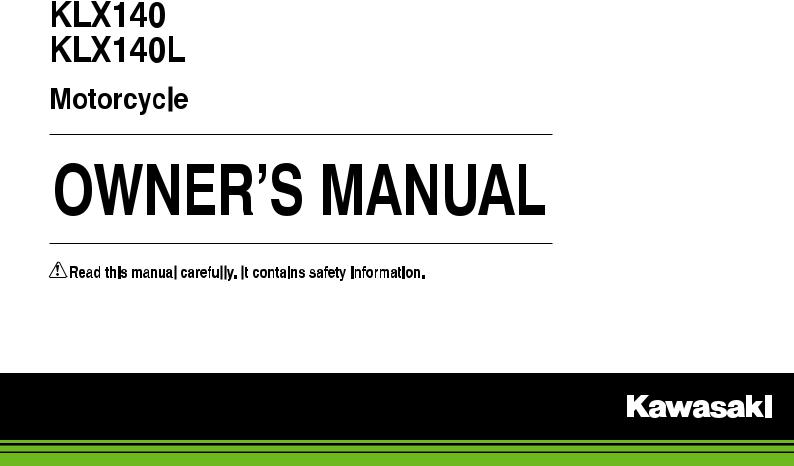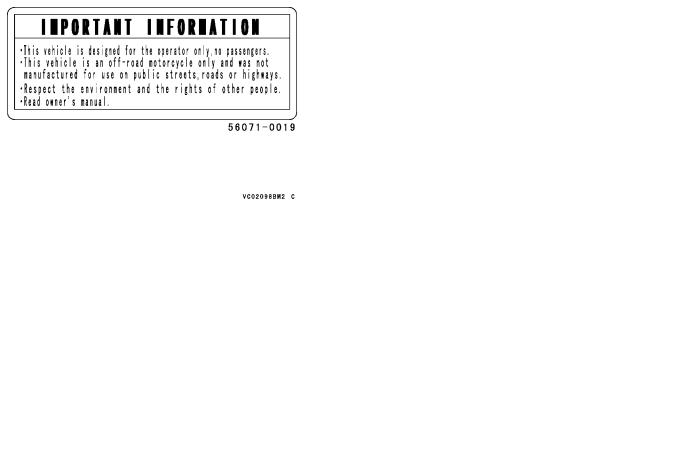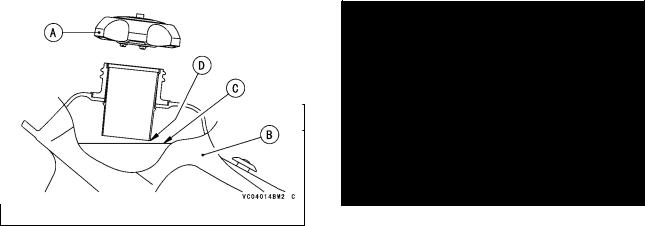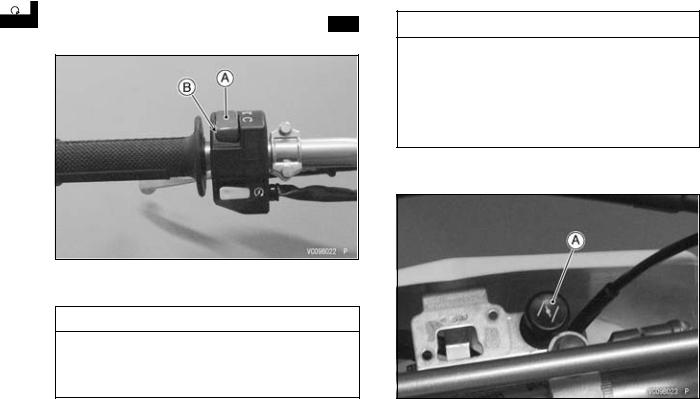Kawasaki KLX140L 2015 Owner's manual

Quick Reference Guide
This Quick Reference Guide will assist you in finding the information you’re looking for.
GENERAL INFORMATION |
j |
|
|
MAINTENANCE AND ADJUSTMENT |
j |
|
|
TROUBLESHOOTING GUIDE |
j |
|
|
STORAGE |
j |
A Table of Contents is included after the Foreword.

IMPORTANT INFORMATION
•This vehicle is designed for the operator only, no passengers.
•This vehicle is an off-road motorcycle only and was not manufactured for use on public streets, roads or highways.
•Respect the environment and the rights of other people.
•Read owner’s manual.

Whenever you see the symbols shown below, heed their instructions! Always follow safe operating and maintenance practices.
 DANGER
DANGER
DANGER indicates a hazardous situation which, if not avoided, will result in death or serious injury.
 WARNING
WARNING
WARNING indicates a hazardous situation which, if not avoided, could result in death or serious injury.
NOTICE
NOTICE is used to address practices not related to personal injury.
NOTE
○NOTE indicates information that may help or guide you in the operation or service of the vehicle.

IMPORTANT
Off-road motorcycling is a wonderful sport, and we hope you will enjoy it to the fullest. However, if improperly conducted, this sport has the potential to cause environmental problems as well as conflicts with other people.
Responsible use of your off-road motorcycle will ensure that these problems and conflicts do not occur. TO PROTECT THE FUTURE OF YOUR SPORT, MAKE SURE YOU USE YOUR MOTORCYCLE LEGALLY, SHOW CONCERN FOR THE ENVIRONMENT, AND RESPECT THE RIGHTS OF OTHER PEOPLE.
 WARNING
WARNING
•THIS VEHICLE IS AN OFF-ROAD VEHICLE ONLY AND WAS NOT MANUFACTURED FOR USE ON PUBLIC STREETS, ROADS, OR HIGH-WAYS.
•USE YOUR BIKE LEGALLY.
•RESPECT THE ENVIRONMENT AND THE RIGHTS OF OTHER PEOPLE.

IMPORTANT NOTE TO PARENTS ABOUT SAFE RIDING
Your youngster’s safety will depend on your commitment to always provide a safe riding environment and a properly maintained vehicle. As with any moving vehicle there are possible safety risks; be sure to heed these precautions.
1.Always equip your child with suitable protective gear and riding apparel. Be sure he or she always wears a helmet, over-the-ankle footwear or sturdy boots, eye protection, groves, long pants, and a long-sleeved shirt while riding.
2.Never allow your child to carry a passenger. This motorcycle is designed for an OPERATOR ONLY.
3.This motorcycle is designed for off-road riding and should never be operated on public roads or paved surfaces.
4.This motorcycle was not designed for hard riding such as motocross.
5.Always obey local off-road riding laws and regulations. Obtain permission to ride on private property.
6.You, the parent (and most likely “riding instructor/mechanic” as well), must be familiar with motorcycle controls and maintenance requirements plus riding techniques. Read and understand the owner’s manual provided with the motorcycle. Review all instructions and warnings with your child.
7.You must determine your child’s readiness to ride this off-road motorcycle. Your child should already be familiar with motorcycle controls (location and function) and basic riding techniques. Your child should also be physically large enough, and strong enough to be able to straddle the motorcycle and hold it up, plus be able to pick up it up if it is on its side.
8.Your child’s safety depends in part on the good mechanical condition of the motorcycle. Be sure to follow the maintenance and adjustment requirements contained in the Periodic Maintenance Chart, Daily Pre-ride Inspection, and After-Race Check Points. Be sure your child understands the importance of checking all items thoroughly before riding the motorcycle. Also, familiarity with the motorcycle is important should a problem occur far from help.
9.Do not allow your child to ride unsupervised. He or she should always ride in the company of an experienced adult.

10.Encourage your child not to ride beyond his or her skill lever or faster than conditions safely allow. Have them practice advanced riding maneuvers under controlled conditions.
11.Tell someone where you and your child are planning to ride and when you Intend to return. Discuss the ride with your child before you leave so he or she will know in advance what riding techniques may be necessary to negotiate the terrain safely. If you are not familiar with the area, lead the way and reduce your speed.
KLX140A only
NOTICE
KLX140A is designed for a rider weighting less than 70 kg (154 pounds). Exceeding this limit could damage the motorcycle.
PLEASE DO NOT TAMPER WITH NOISE CONTROL SYSTEM
To minimize the noise emissions from this product, Kawasaki has equipped it with effective intake and exhaust silencing system. They are designed to give optimum performance while maintaining a low noise level. Please do not remove these systems, or alter them in any way which results in an increase in noise level.
FOREWORD
We wish to thank you for choosing this Kawasaki Motorcycle. It is the end product of Kawasaki’s advanced engineering, exhaustive testing, and continuous striving for superior reliability, and performance. By giving your motorcycle the proper care and maintenance outlined in this manual, you will be helping to ensure it a long, trouble-free life.
Before starting to ride your motorcycle, please read this manual thoroughly in order to know your motorcycle’s capabilities, its limitations, and above all, how to operate it safety.
Due to improvements in design and performance made during production, in some cases there may be minor discrepancies between the actual vehicle and the illustrations and text in this manual.
KAWASAKI HEAVY INDUSTRIES, LTD.
Motorcycle & Engine Company
©2014 Kawasaki Heavy Industries, Ltd. |
Feb. 22, 2014. (1) |

TABLE OF CONTENTS
SPECIFICATIONS............................................ |
10 |
GENERAL INFORMATION.............................. |
13 |
Location of Labels ......................................... |
13 |
Location of Parts ........................................... |
18 |
Side Stand..................................................... |
21 |
Fuel ............................................................... |
21 |
Engine Stop Switch ....................................... |
24 |
Starter Button ................................................ |
25 |
Starting the Engine........................................ |
25 |
Moving Off ..................................................... |
28 |
Shifting Gears................................................ |
28 |
Stopping the Motorcycle................................ |
29 |
Stopping the Engine ...................................... |
30 |
Break-In......................................................... |
30 |
Daily Pre-Ride Checks .................................. |
31 |
MAINTENANCE AND ADJUSTMENT............. |
33 |
Periodic Maintenance Chart .......................... |
33 |
Engine Oil...................................................... |
38 |
Spark Plug..................................................... |
42 |
Air Cleaner .................................................... |
43 |
Throttle Cable................................................ |
48 |
Choke Knob................................................... |
51 |
Idle Speed ..................................................... |
52 |
Clutch ............................................................ |
53 |
Valve Clearance ............................................ |
55 |
Spark Arrester ............................................... |
55 |
Drive Chain.................................................... |
57 |
Handlebar...................................................... |
63 |
Brakes ........................................................... |
65 |
Steering ......................................................... |
68 |
Front Suspension .......................................... |
70 |
Rear Suspension........................................... |
71 |
Wheels .......................................................... |
74 |
Hoses Inspection........................................... |
77 |
Battery ........................................................... |
78 |
Fuse .............................................................. |
82 |
Tightening Torques of Nuts and Bolts............ |
83 |
Cleaning Your Motorcycle.............................. |
88 |
Lubrication..................................................... |
91 |
TROUBLESHOOTING GUIDE......................... |
94 |
STORAGE........................................................ |
96 |
Before Storage .............................................. |
96 |
After Storage ................................................. |
97 |
ENVIRONMENTAL PROTECTION.................. |
98 |
WIRING DIAGRAM .......................................... |
99 |

10 SPECIFICATIONS
SPECIFICATIONS
DIMENSIONS |
|
|
Overall length |
1 820 mm (71.7 in.) |
B: 1 895 mm (74.6 in.) |
Overall width |
790 mm (31.1 in.) |
|
Overall height |
1 050 mm (41.3 in.) |
B: 1 075 mm (42.3 in.) |
Wheelbase |
1 260 mm (49.6 in.) |
B: 1 285 mm (50.6 in.) |
Road clearance |
235 mm (9.3 in.) |
B: 255 mm (10.0 in.) |
Curb Mass |
93 kg (205 lb) |
B: 95 kg (209 lb) |
Fuel tank capacity |
5.8 L (1.5 US gal) |
|
ENGINE |
|
|
Type |
SOHC, 2-valve, single-cylinder, 4-stroke, Air-cooled |
|
Bore × stroke |
58.0 × 54.4 mm (2.3 × 2.1 in.) |
|
Displacement |
144 cm³ (8.8 cu in.) |
|
Compression ratio |
9.5 : 1 |
|
Carburetor |
KEIHIN PB20 |
|
Starting system |
Electric Starter |
|
Ignition system |
CDI |
|
Ignition timing |
10° BTDC @1 400 r/min (rpm) 30° BTDC @4 000 r/min (rpm) |
|
Lubrication system |
Forced lubrication (wet sump) |
|
Spark plug |
NGK CR7HSA |
|
Spark plug terminal |
Screw type |
|
TRANSMISSION
Transmission type Clutch type
Drive system Gear ratios:
1st gear 2nd gear 3rd gear 4th gear 5th gear
Primary reduction ratio Final reduction ratio Overall ratio (top gear) Engine oil:
Capacity Type Viscosity
FRAME
Type
Steering angle Caster
Trail
SPECIFICATIONS 11
5-speed, constant mesh, return shift Wet, multi disc
Chain drive
2.667 (40/15)
1.895 (36/19)
1.474 (28/19)
1.182 (26/22)
1.000 (24/24)
2.880 (72/25)
3.571 (50/14)
10.286
1.1 L (1.2 US qt)
API SG, SH, SJ, SL or SM with JASO MA, MA1 or MA2 SAE 10W-40
Tubular, semi-double cradle |
|
41° to either side |
|
27° |
|
85 mm (3.3 in.) |
B: 96 mm (3.8 in.) |
12 SPECIFICATIONS
Tire size, type:
Front
Rear
Rim size: Front Rear
Suspension: Front Rear
Front suspension travel Rear wheel travel Front fork oil:
Type
Amount (per fork leg)
BRAKES
Type (Front & Rear)
ELECTRICAL EQUIPMENT
Battery
B: KLX140B
70/100-17 40M, IRC., LTD. IX05H B: 70/100-19 42M, IRC., LTD. IX05H
90/100-14 49M, IRC., LTD. IX05H B: 90/100-16 52M, IRC., LTD. IX05H
17 |
× 1.40 |
B: 19 × 1.40 |
14 |
× 1.60 |
B: 16 × 1.85 |
Telescopic fork |
|
|
New Uni-trak® swingarm |
|
|
180 mm (7.1 in.) |
|
|
180 mm (7.1 in.) |
|
|
Kawasaki Fork Oil SS-8 |
|
|
296 mL (10.0 US oz) |
B: 290 mL (9.8 US oz) |
|
Disc |
|
|
12 |
V 6 Ah |
|
Specifications are subject to change without notice, and may not apply to every country.

GENERAL INFORMATION 13
|
|
|
|
|
|
j |
|
GENERAL INFORMATION |
|
|
|||
|
|
|
|
|||
|
|
|
|
|
|
|
|
|
|
|
|
|
|
Location of Labels |
|
|
|
|
|
|
All warning labels which are on your vehicle are |
|
|
|
|
|
|
repeated here. Read labels on your vehicle and un- |
|
|
|
|
|
|
derstand them thoroughly. They contain information |
|
|
|
|
|
|
which is important for your safety and the safety of |
|
|
|
|
|
|
anyone else who may operate your vehicle. There- |
|
|
|
|
|
|
fore, it is very important that all warning labels be on |
|
|
|
|
|
|
your vehicle in the locations shown. If any label is |
|
|
|
|
|
|
missing, damaged, or worn, get a replacement from |
|
|
|
|
|
|
your Kawasaki dealer and install it in the correct po- |
|
|
|
|
|
|
sition. |
|
|
|
|
|
|
NOTE |
|
|
|
|
|
|
|
1. Brake Fluid (Front) |
|
||||
○The sample warning labels in this section have |
|
|
||||
|
|
|
|
|
||
part numbers to help you and your dealer obtain |
|
|
|
|
|
|
the correct replacement. |
|
|
|
|
|
|

14 GENERAL INFORMATION
 j
j
2. Brake Fluid (Rear)
3. Rear Shock Absorber Warning (KLX140A)
4. Important Information
5. Helmet (Thailand Model)

GENERAL INFORMATION 15
j
6. Battery Poison/Danger

16 GENERAL INFORMATION
j |
1) |
3) KLX140A |
|
|
|
|
2) |
4) |
|
|
|
|
|
|
|

GENERAL INFORMATION 17
5) Thailand Model |
6) |
|
j |
|
|
|
|||
|
|
|
|
|
|
|
|
|
|

18 GENERAL INFORMATION
 j
j
Location of Parts
1. |
Clutch Lever |
5. |
Front Brake Lever |
2. |
Engine Stop Switch |
6. |
Throttle Grip |
3. |
Choke Knob |
7. |
Starter Button |
4. |
Front Brake Fluid Reservoir |
8. |
Fuel Tank Cap |

GENERAL INFORMATION 19
j
9. |
Front Fork |
16. |
Brake Caliper |
10. |
Fuel Tank |
17. |
Engine Oil Drain Plug |
11. |
Fuel Tap |
18. |
Side Stand |
12. |
Carburetor |
19. |
Drive Chain |
13. |
Seat |
20. |
Swingarm |
14. |
Air Cleaner Element |
21. |
Chain Guide |
15. |
Brake Disc |
22. |
Rear Shock Absorber |

20 GENERAL INFORMATION
 j
j
23. |
Muffler |
27. |
Chain Adjuster |
24. |
Fuse |
28. |
Rear Brake Fluid Reservoir |
25. |
Battery |
29. |
Oil Filler Cap/Dipstick |
26. |
Rear Axle Nut |
30. |
Rear Brake Pedal |

Side Stand
The motorcycle is equipped with a side stand.
A. Side Stand
Do not sit on the motorcycle while it is on its side stand. Always kick the stand fully up before sitting on the motorcycle.
 WARNING
WARNING
Riding with the side stand down could cause an accident resulting in serious injury or death. Always be sure the side stand is fully raised before riding.
GENERAL INFORMATION 21
j
Fuel
Fuel Requirements:
Your Kawasaki engine is designed to use only unleaded gasoline with a minimum octane rating shown below. Never use gasoline with an octane rating lower than the minimum specified by Kawasaki to prevent severe engine damage.
The octane rating of a gasoline is a measure of its resistance to detonation or “knocking”. The term commonly used to describe a gasoline’s octane rating is the Research Octane Number (RON).
NOTICE
If engine “knocking" or “pinging" occurs, use a different brand of gasoline of a higher octane rating. If this condition is allowed to continue, it can lead to severe engine damage.Gasoline quality is important. Fuels of low quality or not meeting standard industry specifications may result in unsatisfactory performance.

22 GENERAL INFORMATION
j |
|
Fuel Type and Octane Rating |
|
|
|||
|
|
||
|
|
Use clean, fresh unleaded gasoline with an octane |
|
|
|
rating equal to or higher than that shown in the table. |
|
|
|
Fuel Type |
Unleaded Gasoline |
|
|
Ethanol |
E10 or less |
|
|
Content |
|
|
|
|
|
|
|
Minimum |
Research Octane Number (RON) |
|
|
Octane Rating |
91 |
NOTICE
Do not use any fuel that contains more ethanol or other oxygenates than specified for E10 fuel* in this vehicle. Damage to the engine and fuel system, or engine starting and/or performance problems may result from the use of improper fuel.
*E10 means fuel containing up to 10% ethanol.
NOTE
○In case of using E10 fuel, it is necessary to change carburetor setting.
Filling the Tank:
Avoid filling the tank in the rain or where heavy dust is blowing so that the fuel does not get contaminated.
A.Tank Cap
B.Fuel Tank
C.Top Level
D.Filler Neck

 WARNING
WARNING
Gasoline is extremely flammable and can be explosive under certain conditions. Always stop the engine and do not smoke. Make sure the area is well ventilated and free from any source of flame or sparks; this includes any appliance with a pilot light.
Never fill the tank so the fuel level rises into the filler neck. If the tank is overfilled, heat may cause the fuel to expand and overflow through the vents in the tank cap. After refueling, make sure the fuel tank cap is closed securely. If gasoline is spilled on the fuel tank, wipe it off immediately.
NOTICE
Certain ingredients of gasoline may cause paint fading or damage. Be extra careful not to spill gasoline or gasoline oxygenates blends during refueling.
GENERAL INFORMATION 23
j
Fuel Tap:
The fuel tap has three position: OFF, ON, and RES (reserve). For normal operation, turn the fuel tap lever to the ON position. If the fuel runs out with the tap in the ON position, the last approximately 1.1 L (0.29 US gal) of usable fuel remains can be used by turning the tap lever to the RES position.
A.Fuel Tap
B.ON Position
C.OFF Position
D.RES Position
Turn the fuel tap lever to OFF position when the fuel tank is removed for maintenance and adjustments or the motorcycle is stored for a long time.

24 GENERAL INFORMATION
j |
NOTE |
|
○Since riding distance is limited when on RES, refuel at the earliest opportunity.
○Make certain that the fuel tap lever is turned to ON (not RES), after filling up the fuel tank.
 WARNING
WARNING
Practice operating the fuel tap with the motorcycle stopped. To prevent an accident you should be able to operate the fuel tap while riding without taking your eyes off the road. Be careful not to touch the hot engine while operating the fuel tap.
Engine Stop Switch
The engine stop switch is located on the left side of the handlebar. The engine stop switch must be in the
 position for the motorcycle to operate. Move the switch to the
position for the motorcycle to operate. Move the switch to the  position to stop the engine.
position to stop the engine.
NOTE
○To avoid battery discharging, check that the en-
gine stop switch is in the  position and the indicator light (orange LED) goes off, when the motorcycle is not used.
position and the indicator light (orange LED) goes off, when the motorcycle is not used.
A.Engine Stop Switch
B.Indicator Light (LED)

|
|
GENERAL INFORMATION 25 |
||
|
|
|
|
j |
Starter Button |
|
Starting the Engine |
|
|
This motorcycle has the starter button. The starter |
|
• Turn the fuel tap lever to the ON position. |
||
button operates the electric starter when the clutch |
|
|
|
|
lever pulled in. |
|
|
|
|
|
|
|
|
|
|
A. ON Position |
|
• Shift the transmission into neutral. |
A. Starter Button |
|
|
NOTE |
|
○This motorcycle is equipped with a neutral switch |
|
that prevents the engine from starting when the |
|
transmission is not in neutral. |

26 GENERAL INFORMATION
j
• Check that the engine stop switch is in the position.
NOTICE
Do not operate the starter continuously for more than 5 seconds, or the starter will overheat and the battery power will drop temporarily.
Wait 15 seconds between each operation of the starter to let it cool and the battery power recover.
When engine is cold:
• Pull out the choke knob.
A.Engine Stop Switch
B. Position
Position
 WARNING
WARNING
Riding with the side stand in the down position can cause a crash resulting in injury. Do not start the engine or attempt to ride the motorcycle when the side stand is down.
A. Choke Knob
•Leaving the throttle completely closed, push the starter button until the engine starts.

NOTE
○When the clutch lever is pulled, the motorcycle can be started with the transmission in any gear.
GENERAL INFORMATION 27
|
|
j |
NOTICE |
|
|
|
|
|
Do not let the engine idle longer than five |
|
|
minutes, or engine overheating and damage |
|
|
may occur. |
|
|
A.Starter Button
•Even after the engine has started, do not push back immediately the choke knob until the engine is thoroughly warmed up.
NOTE
○When the engine is already warm or on a hot day, open the throttle part way instead of using the choke knob.

28 GENERAL INFORMATION
 j
j
Moving Off
•Check that the side stand is up.
•Shift into 1st gear.
•Open the throttle slowly.
Shifting Gears
This motorcycle is equipped with a 5-speed “return shift” transmission. The neutral is located halfway between 1st and 2nd gear. “Return shift” means that when shifting up or down, each gear must be engaged before the next higher or lower gear may be selected.
•To engage first gear from the neutral position, pull in the clutch lever and push down on the shift pedal, gently release the clutch lever, then release the shift pedal.
•To shift up to the next gear, pull in the clutch lever, lift the shift pedal with your toes, gently release the clutch lever, and then release the shift pedal.
•To shift down to the next gear, pull in the clutch lever, push the shift pedal down as far as it will go, gently release the clutch lever, then release the shift pedal.
 WARNING
WARNING
Downshifting to a lower gear at high speed causes engine rpm to increase excessively, potentially damaging the engine and it may also cause the rear wheel to skid and cause an accident.

NOTICE
When changing gears, press firmly on the shift pedal to ensure proper shifting. Careless, incomplete shifting can cause the transmission to jump out of gear and lead to engine damage.
GENERAL INFORMATION 29
j
Stopping the Motorcycle
For maximum deceleration, close the throttle and apply both front and rear brakes. Pull in the clutch lever as the motorcycle comes to a stop. Independent use of the front or rear brake may be advantageous in certain circumstances. Shift down progressively to ensure good engine response at all speeds.
A. Shift Pedal
